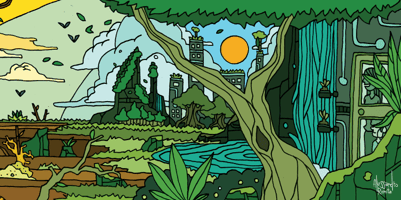For the past few years, our community team has led hack-a-thons to engage with the development community. Since the COVID-19 pandemic, we’ve taken our hack-a-thons online, allowing us to expand to a worldwide audience. With that worldwide perspective in mind, our 2021 Build Tomorrow Hack-a-thon focused on how a collaboration SDK can allow teams to solve global problems.

With over 1400 registered developers, there was no shortage of great ideas. Though we wish we could take the time to shed light on all of the great work done, there simply aren’t enough hours in the day. Instead we’re going to highlight how a few developers used our features in ways we had never seen before, and maybe give you a little inspiration to see what you can do with our collaboration SDK and API.
Enabling real-time health planning with Tasks and Activity Feeds
MEDBAY, the project by our third place winners Jayit Saha & Ishita Dasgupta, was designed to bring a new standard of care to telehealth by enabling more real-time capabilities and automated functionality. The scope of the project was expansive and comprehensive, addressing as many aspects of telemedicine as possible, with a keen focus on expanding access to care while still helping physicians manage their time.
There were quite a few features worth highlighting: using Chatbots to address more common healthcare questions, using our secure file sharing features to safely share sensitive medical documents online, and using our Microsoft Teams integration to enable video calls. But the feature that got our attention was their inventive use of Tasks and Activity Feeds.

Crucial to the design of MEDBAY is the idea of doctor and patient dashboards. On the doctor dashboard, a physician can get a bird’s eye view of all their active patients and their treatment plans. On the patient dashboard, the patient can get an overview of their treatment. What links the dashboards is Tasks and Activity Feeds. Through this tool, a physician can assign important tasks to the patient. These tasks could be anything from “make sure to drink more water” to prescribing lab diagnostics.
The best part is that the patient can mark tasks completed as they’re being done, and using activity feeds the patient can give updates one what did or did not help their wellbeing. This kind of organized communication allows the physician to get important treatment updates between visits, enabling them to ask better questions and tailor follow-up care.
Using Document Collaboration to supercharge remote learning
Second place winners “The Inevitables” wowed us with Project Horizon, a virtual classroom platform designed to smooth out some of the frustrations that arose as education became fully online during the 2020 COVID-19 Pandemic. Project Horizon is designed to act as a full service virtual classroom where students and educators can gather in an organized fashion that recreates some of the ideal aspects of a real world classroom environment. This included using group chats and direct messages to enable conversations, or using tasks to manage assignments and duties. As most schools turned to Zoom to conduct online learning last year, Project Horizon leveraged our Zoom call integration to make the experience of starting a virtual lecture seamless.

But the element that really brought the whole experience together was how the team implemented Document Collaboration to make Project Horizon a fully functional LMS. By using the folders feature in file sharing, teachers could create spaces to distribute reading materials, coursework, worksheets, exams, and anything else students need to engage with the curriculum.
Students can also use the folders to securely upload completed assignments, with version control to make sure that work isn’t being modified after it was turned in. Furthermore, using the comments feature built into our file sharing, teachers can leave feedback on the completed work that students can view at any time.
Connecting Activity Feeds with APIs to expedite urban renewal
Mehul Nirala, our first place winner, won over the jury with their truly inventive Urban Repair project. To quote Mehul:
“A city is an important public resource. There are issues like cleanliness, property damage, etc. in a city that often go overlooked for a long period of time. We wanted to build a platform that would empower everyone to bring attention to pressing problems. Collaboration makes it easy to address a problem that is usually difficult to address on an individual level.”
Mehul achieved this by creating a portal that connects residents with their local municipal services. By doing so, Mehul effectively crowdsourced one of the most difficult elements of infrastructure maintenance: identifying issues and creating prioritization. In this portal, residents can not only identify infrastructure issues like potholes or malfunctioning equipment, but upload images, write descriptions of the problems, and use geotagging to give the exact location of the problems.

The biggest achievement of Urban Repair is how Mehul modified Weavy’s server SDK to connect Weavy’s collaboration features directly to the OpenStreetMap API. By doing so, residents can not only photograph and describe issues throughout the city, but precisely pin the issue on the map. Anyone using Urban Repair can then see all the pins on the map, and click on one to see all the important information around the issue.

Building on this concept, Mehul connected the image upload with Microsoft’s Azure Vision API, allowing for images to be tagged dynamically, creating searchable metadata to help city planners easily filter problems by type.
We were beyond impressed with the results of this year’s hack-a-thon, and the robust use-cases that our participants were able to create and implement in such a short period of time.